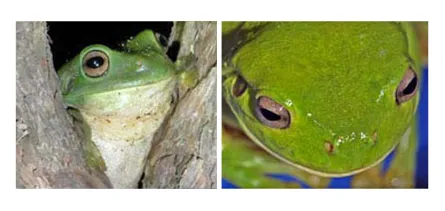During Australia’s dry season, green tree frogs apparently can pull a drink out of thin air.

Even on chilly nights, green tree frogs (Litoria caerulea) unexpectedly turn up outside the warm, cozy tree cavities where they take shelter. Experimenting with frogs in a real tree as well as in a lab version made of PVC pipe shows that chilled frogs get welcome water condensing on them when they hop back inside from the cold, Christopher Tracy of the University of Melbourne in Australia and his colleagues report in the October American Naturalist.
“It’s a mechanism where they can get a little bit of water, and that little bit of water might be very important,” Tracy says. Researchers found that frogs air-cooled below 15° Celsius accumulated 0.03 percent to 0.54 percent of their body mass in condensation. Every drop of water helps during the dry season in the northern part of Australia’s Northern Territory, where from June through August it typically doesn’t rain at all.
This study documents for the first time the actual water gains available from condensation in an animal’s refuge, says physiological ecologist Harvey Lillywhite of the University of Florida in Gainesville, who notes having seen condensation droplets on geckos sheltering under rocks in summer.
The strategy is a trade-off for the animals that employ it, however, because leaving a humid refuge for the dry, cold night air increases water loss through the skin. Using a computer model, Tracy and colleagues calculated that a typical frog would come out ahead if it stayed outside for the half an hour or so necessary to chill to the temperature of the night air.
A misjudgment of time or temperature, however, could end up losing a frog water in the end, says comparative physiologist Stanley Hillman of Portland State University in Oregon. Collecting condensation certainly could work, but he says he’ll need more observations before he’s convinced that the process makes a difference in the lives of real frogs.






